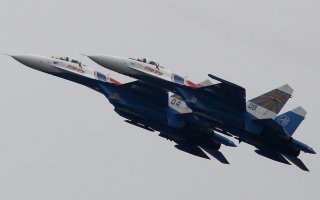45 'Foreign Aircraft': Russia Claims to Have Detected Spy Aircraft Near its Border
It is unclear if these were the same aircraft in both incidents.
The skies near Russia must be quite crowded if recent news reports are to be believed. The Russian Defense Ministry’s Krasnaya Zvezda newspaper reported last week that Russian radar tracked forty-five foreign aircraft that were alleged to have conducted air reconnaissance near the state borders. The paper’s infographics showed that these included thirty-five foreign “spy planes” as well as eleven drones.
All the flights conducted by the foreign aircraft were tracked by Russian radar stations, and state media reported that no violations of the Russian state border “were allowed.” Russian media also claimed that in the past week, Russian pilots carried out 342 flight shifts at seventy-seven aerodromes as part of their combat training and that included counter-reconnaissance efforts.
Among the recent incidents was the detection of two “air targets” over the Black Sea that approached Russia’s state border on August 14.
“A Su-27 fighter plane from the Southern Military District’s air defense quick reaction alert forces was scrambled to identify the targets,” Russia’s National Defense Control Center told Tass. “The Russian fighter’s crew consistently approached the air objects at a safe distance and identified them as a US Air Force RC-135 reconnaissance plane and a US Navy P-8A Poseidon maritime patrol aircraft.”
The National Defense Control Center also identified a U.S. Navy EP-3E Aries II reconnaissance aircraft over the Black Sea. The land-based Multi-Intelligence EP-3E Aries II is based on the P-3 Orion airframe and is able to provide fleet and theater commanders with near real-time tactical SIGINT (signals intelligence) as well as full-motion video intelligence.
State media added that after the U.S. “spy planes” moved away from Russia’s state border, the Su-27 fighter safely returned to its home airfield.
This was just the latest claim made by the Russian Defense Ministry, which earlier this month reported that another Sukhoi Su-27 fighter was scrambled to intercept two reported spy planes, also over the Black Sea. Those two air targets were further identified as a U.S Air Force RC-135 reconnaissance plane and a U.S. Navy P-8A Poseidon maritime patrol aircraft, and both were on routine flights over the neutral waters of the Black Sea.
It is unclear if these were the same aircraft in both incidents.
The Air Force operates twenty-four of the 707-based RC-135 reconnaissance aircraft in various configurations, and the planes are used to listen in on signals traffic, geolocate their points of origin and profile electromagnetic signatures. The RC-135 can also be used to analyze radar emissions produced by potential adversaries to profile their systems and to develop countermeasures against them. The RC-135 has been used to study North Korea’s intercontinental-class ballistic missile (ICBM) program.
The U.S. Navy’s Boeing P-8 Poseidon (formerly Multimission Maritime Aircraft), can operate as an anti-submarine warfare (ASW), anti-surface warfare (ASUW) and in a shipping interdiction role. It is armed with torpedoes, Harpoon anti-ship missiles but it can also drop and monitor sonobuoys and operate in conjunction with other assets including maritime surveillance unmanned aerial vehicles (UAVs).
Last year, the U.S. Navy awarded Boeing a $2.4 billion deal to build nineteen more of the aircraft, which is based on Boeing’s 737-800 aircraft. The aircraft will be used to help hunt Chinese submarines.
Peter Suciu is a Michigan-based writer who has contributed to more than four dozen magazines, newspapers and websites. He is the author of several books on military headgear including A Gallery of Military Headdress, which is available on Amazon.com.
Image: Reuters

